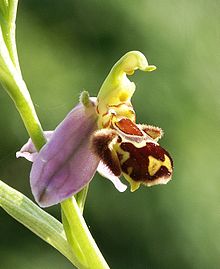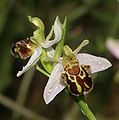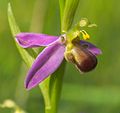Bee ragwort
| Bee ragwort | ||||||||||||
|---|---|---|---|---|---|---|---|---|---|---|---|---|

Bee ragwort ( Ophrys apifera ) |
||||||||||||
| Systematics | ||||||||||||
|
||||||||||||
| Scientific name | ||||||||||||
| Ophrys apifera | ||||||||||||
| Huds. |
The bee orchid ( Ophrys apifera ) is a late flowering type from the genus of Ragwurzen ( Ophrys ) of the family of orchid (Orchidaceae).
In order to draw attention to the particular endangerment of this species, the bee orchid was selected by the local orchid working group as the orchid of the year 1995 .
description

The bee orchid is a perennial , herbaceous growing Knollengeophyt cm reached, the plant height of 20 to 50. Two to four leaves are arranged in a rosette and are 6 to 13 cm long. The basic color of the leaves is green with a silvery "shimmer". The rosette of leaves sprouts in early autumn.
The inflorescences are loose-flowered spikes with three to ten flowers . The sepals are light to strong pink in color and when the flower is fully open they are usually turned back far. The petals are green to pink, often hairy and 3 to 8 mm long. The lip is three-lobed when spread out and 10 to 15 mm long. The middle lobes are dark brown, the basal field is light brown. The mark is grayish blue with a light border, more or less encompassing the basal field. The appendage is very large, but usually not visible from the front, as the edge of the middle lobe folds backwards. The lateral lobes have large, hairy humps.
The number of chromosomes is 2n = 36.
Reproduction
The flowers of the bee ragwort are rarely cross- pollinated by insects . Usually self-pollination occurs . The pollinia stalks curve downwards, bringing the pollinia into contact with the stigma. This is very rare with orchids, because here reproduction is mostly based on cross- pollination .
Occurrence and distribution
It occurs in base-rich dry grasslands and grasslands , also in light deciduous and coniferous forests. She prefers not too dry locations. It is a character species of the Mesobromion association, but also occurs in societies of the Erico-Pinion or Quercion pubescentis associations.
Climatically favored areas in Europe , North Africa , the Middle East , the Caucasus . In Germany, most of the sites are in Baden-Württemberg , Thuringia , southern Lower Saxony and Saarland , and the species is rare to very rare. In Austria it is endangered and occurs in several federal states, the focus is in the east and south (Vienna, Lower Austria, Burgenland, Styria).
According to Baumann and Künkele , the species has the following altitude limits in the Alpine countries: Germany 10–910 meters, France 1–1475 meters, Switzerland 260–1180 meters, Liechtenstein 430–1150 meters, Austria 275–780 meters, Italy 10–1570 meters, Slovenia 20-550 meters. In Europe the species rises up to 1570 meters above sea level, in Morocco up to 1800 meters.
Others
The number of flowering plants varies considerably from year to year. The drier the winter and spring, the lower the number. In the summer of 2003 , the number was very low. Several blooming plants could only be observed in slightly shaded or slightly more humid locations. The number of plants in some regions has also been severely decimated; in autumn there were significantly fewer leaf rosettes than in the previous autumn.
The plants are sometimes not very long-lived. Often they bloom only a few times and then disappear again or they need a few years until the next bloom. The reason for this is likely to be self-pollination. The expenditure of energy for seed production weakens the plants.
Since the beginning of the 1990s, the colonization of new locations has been increasingly observed where it has never been seen before. In suitable locations, the number of plants can increase sharply in just a few years. It only takes three to four years from the seed to the flowering plant.
Subspecies and varieties
Several subspecies and varieties of the bee ragwort have been described:
- Ophrys apifera ssp. jurana Ruppert (1911)
- Ophrys apifera var. Aurita (Moggr.) Gremli (1887) - narrow, but prolonged Petalen
- Ophrys apifera var. Bicolor E. Nelson (1962) - bicolor lip
- Ophrys apifera var. Botteronii (Chodat) Brand (1905) - similar to var. Friburgensis
- Ophrys apifera var. Flavescens Rosbach (1880) - Yellow lip
- Ophrys apifera var. Friburgensis Freyhold (1879) - petals shaped like sepals
- Ophrys apifera var. Trollii (Hegetschw.) Rchb.f. (1851) - Sometimes almost absent, lip appendages stretched forward
Danger

Due to the late flowering period, sites are often mowed before flowering or seed ripening. Progressive succession takes away the light from the plants and sooner or later they disappear.
literature
- Working groups local orchids (ed.): The orchids of Germany. Working groups of domestic orchids, Uhlstädt-Kirchhasel 2005, ISBN 3-00-014853-1 .
- Helmut Baumann, Siegfried Künkele: The wild growing orchids of Europe. Franckh, Stuttgart 1982, ISBN 3-440-05068-8 .
- Karl-Peter Buttler : Orchids. The wild growing species and subspecies of Europe, the Middle East and North Africa (= Steinbach's natural guide. 15). Mosaik, Munich 1986, ISBN 3-570-04403-3 .
- Robert L. Dressler: The orchids - biology and systematics of the Orchidaceae (original title: The Orchids. Natural History and Classification. Harvard University Press, Cambridge, Mass. Et al. 1981). Translated by Guido J. Braem with the assistance of Marion Zerbst. Bechtermünz, Augsburg 1996, ISBN 3-86047-413-8 .
- Hans Sundermann : European and Mediterranean orchids. 2nd Edition. Brücke, Hildesheim 1975, ISBN 3-87105-010-5 .
- John G. Williams, Andrew E. Williams, Norman Arlott: Orchids of Europe with North Africa and Asia Minor (= BLV determination book. 25). Translated, edited and supplemented by Karl-Peter Buttler and Angelika Rommel. BLV, Munich / Bern / Vienna 1979, ISBN 3-405-11901-4 .
- Niklfeld, H. et al. (1999): Red Lists of Endangered Plants in Austria. Green series of the Federal Ministry for the Environment, Youth and Family, Vienna.
Individual evidence
- ↑ a b Erich Oberdorfer : Plant-sociological excursion flora for Germany and neighboring areas . 8th edition. Verlag Eugen Ulmer, Stuttgart 2001, ISBN 3-8001-3131-5 . Page 278.
- ↑ a b Helmut Baumann , Siegfried Künkele : Orchidaceae . In: Oskar Sebald u. a .: The fern and flowering plants of Baden-Württemberg. 1st edition Volume 8, page 421. Verlag Eugen Ulmer, Stuttgart 1998. ISBN 3-8001-3359-8
Web links
- Bee ragwort. In: FloraWeb.de.
- Bee ragwort . In: BiolFlor, the database of biological-ecological characteristics of the flora of Germany.
- Profile and distribution map for Bavaria . In: Botanical Information Hub of Bavaria .
- Thomas Meyer: Data sheet with identification key and photos at Flora-de: Flora von Deutschland (old name of the website: Flowers in Swabia )
- Distribution maps
- Distribution in Europe and neighboring areas
- Distribution map for Germany. In: Floraweb .
- Germany (AHO)
- Switzerland (AGEO)
- Regional links







